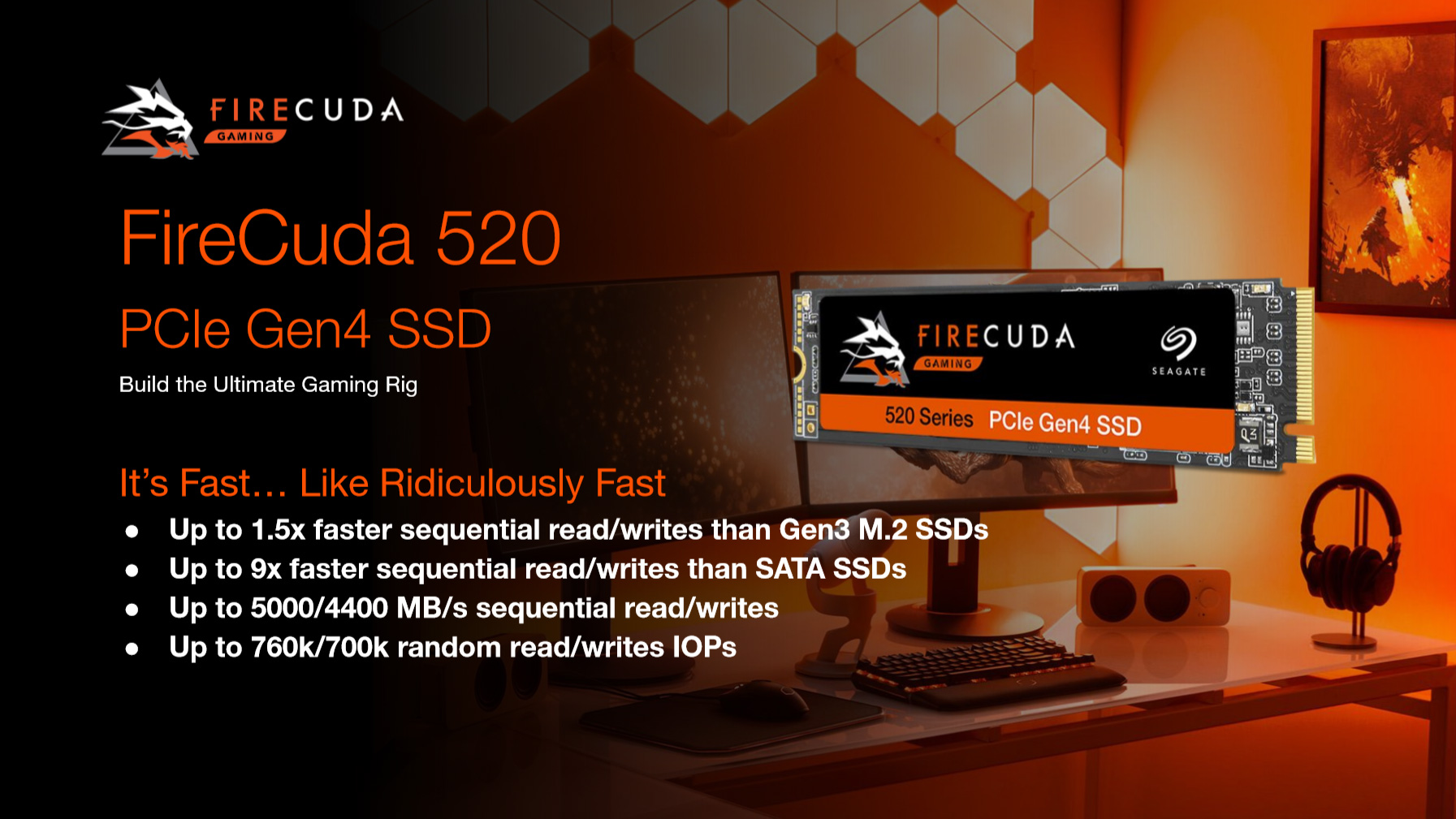Seagate Announces Thunderbolt 3 Gaming Dock and New FireCuda SSDs
Seagate backs up a truckload of flash, and introduces a gaming dock, too.
Seagate is blazing up a firestorm with the release of two new storage products for gamers, a new gaming dock, and a PCIe 4.0 x4 FireCuda SSD. The company is also refreshing a few of the other SSDs in its lineup, too.

FireCuda Gaming Dock
Seagate’s FireCuda Gaming Dock is a high-end gaming hub that integrates a docking station and external storage into one device. It’s meant to be a perfect fit for laptop gamers who aren’t ready to jump on the desktop gaming PC bandwagon yet.

As many laptops are constrained by storage, Seagate is launching the unit with 4TB 7200RPM HDD inside for those growing game libraries. The company also threw in a PCIe 3.0 x4 M.2 expansion slot just in case you’re looking to add some high-speed NVMe storage, too.
The dock features one-cord plug-and-play connectivity over a single Thunderbolt 3 input. There are also 10 connections to the docking station to connect your other peripherals.
• 1x TB3 port for accessory devices
• 1x DisplayPort 1.4
• 4x USB 3.1 Gen 2 ports
Get Tom's Hardware's best news and in-depth reviews, straight to your inbox.
• 1x USB 3.1 Gen 2 battery charge port
• 1x RJ45 Ethernet network port
• 1x 3.5mm audio-in / mic port
• 1x 3.5mm audio-out port
Unfortunately, there is no charging support for laptops, so you will have to use your power brick when you're connected to the dock. But it offers a slick industrial design with LED illumination. It comes to market with an MSRP of $349.99 and a three-year warranty.
FireCuda 520 SSD
If the gaming dock wasn’t enough to spark your interest, Seagate’s new PCIe 4.0 x4 M.2 NVMe SSD just might. It’s Seagate's top-of-the-line SSD, and a solid choice to add some more speed to your new AMD Ryzen 3000 build.

Like a few other PCIe 4.0 SSDs in the market, Seagate’s FireCuda 520 features a Phison E16 SSD controller that has been validated by the company. Paired with Kioxia’s 96L BiCS4 TLC NAND flash, Seagate says this combo enables incredible performance with up to 5,000/4,400 MBps of sequential read/write throughput and up to 760,000/700,000 random read/write IOPS.
The drive comes with a black PCB and has an MTBF rating of 1.8M hours. It also comes with a five-year warranty with endurance figures of up to 3,600 TB to match. Available now, Seagate’s FireCuda 520 comes in three capacities: 500GB, 1TB, and 2TB.
MSRPs are $124.99 (500GB), $249.99 (1TB), and $429.99 (2TB).
FireCuda 510 SSD Refresh
While the FireCuda 520 launch steals the spotlight, Seagate’s FireCuda 510 PCIe 3.0 x4 M.2 NVMe SSD gets some love, too. Today, Seagate told us that it is refreshing the FireCuda 510 with new hardware.
First, Seagate added in a black PCB to appeal for those concerned about aesthetics. Who likes ugly blue and green PCBs distracting from your blacked-out or red accented gaming build, anyways?
Seagate also swapped out the NAND from 64L BiCS3 to the latest Kioxia 96L BiCS4 flash. They have also added in a 500GB capacity point because high-capacity models are a hot seller.
Barracuda 510 SSD Refresh
Just as the FireCuda is expanding to smaller capacities, the company’s mainstream PCIe 3.0 x4 M.2 NVMe SSD, the BarraCuda 510, is getting a 1TB model. Like the FireCuda, the BarraCuda features a Seagate-validated Phison E12 SSD controller and the latest Kioxia 96L BiCS4 flash, but not the fancy black PCB.

The main difference between the BarraCuda 510 and FireCuda 510, other than aesthetics and capacity points, is that the BarraCuda is a single-sided M.2 SSD optimized for flexible compatibility, while FireCuda is a double-sided M.2 solution optimized for enhanced performance and greater endurance.
BarraCuda 120 SSD Refresh
To conclude the refresh list, we finally have the BarraCuda 120 SSD. Seagate’s BarraCuda 120 is a 2.5 in × 7mm SATA 6Gb/s SSD that replaces the previous BarraCuda SSD.
Seagate replaced the internals with new and up-to-date hardware. The company also swapped out the aging S10 SSD controller and replaced it with a Phison S12 SATA controller to ready it for 3D NAND. Seagate will have two sources of NAND for this SSD. Depending on inventory, the BarraCuda 120 will come with either Kioxia 96L BiCS4 TLC or Micron 64L TLC to ensure consistent supply.

Sean is a Contributing Editor at Tom’s Hardware US, covering storage hardware.